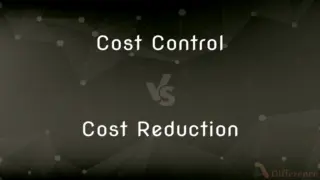Polar Dielectrics vs. Nonpolar Dielectrics — What's the Difference?
By Tayyaba Rehman — Published on December 18, 2023
Polar Dielectrics have permanent electric dipole moments, while Nonpolar Dielectrics lack them, leading to differences in electrical properties.

Difference Between Polar Dielectrics and Nonpolar Dielectrics
Table of Contents
ADVERTISEMENT
Key Differences
Polar Dielectrics are materials that inherently possess electric dipole moments. This means their positive and negative charges are separated, giving them an inherent polarity. On the other hand, Nonpolar Dielectrics are materials where positive and negative charges are evenly distributed, meaning they don't have a natural electric dipole moment.
When an external electric field is applied, Polar Dielectrics tend to align their dipoles with the field, causing a higher polarization. In contrast, Nonpolar Dielectrics rely mainly on the slight distortion of their electron clouds, known as electronic polarization, which typically results in a weaker response.
The electrical behavior of Polar Dielectrics often shows more pronounced non-linear characteristics because of the alignment and reorientation of their dipoles. Nonpolar Dielectrics, with their lack of inherent dipoles, typically exhibit more linear electrical characteristics.
Due to the presence of permanent dipoles, Polar Dielectrics generally have higher dielectric constants than Nonpolar Dielectrics. This property makes them more effective in storing electrical energy.
In applications like capacitors, where dielectric materials are used, the choice between Polar Dielectrics and Nonpolar Dielectrics can impact the device's performance. Polar Dielectrics often provide higher capacitance, while Nonpolar Dielectrics might offer better frequency and temperature stability.
ADVERTISEMENT
Comparison Chart
Electric Dipole Moment
Inherent presence
Absent
Response to External Field
Stronger due to dipole alignment
Weaker due to only electronic polarization
Electrical Characteristics
More non-linear
Typically more linear
Dielectric Constant
Generally higher
Generally lower
Application Behavior
Provides higher capacitance
Offers better frequency and temperature stability
Compare with Definitions
Polar Dielectrics
Polar Dielectrics can realign their dipoles in response to an external electric field.
Under an electric field, the dipoles in Polar Dielectrics like barium titanate tend to align with the field.
Nonpolar Dielectrics
Nonpolar Dielectrics lack inherent electric dipole moments because of their symmetrical charge distribution.
Helium gas, a Nonpolar Dielectric, doesn't have an inherent dipole.
Polar Dielectrics
The inherent dipoles in Polar Dielectrics make them effective in energy storage applications.
Capacitors using Polar Dielectrics can achieve high capacitance values.
Nonpolar Dielectrics
Nonpolar Dielectrics tend to offer better stability across a range of frequencies and temperatures.
Nonpolar Dielectrics like Teflon are preferred in high-frequency applications due to their stability.
Polar Dielectrics
Polar Dielectrics are materials with built-in electric dipoles due to charge separation.
Water molecules in Polar Dielectrics have a distinct positive and negative end.
Nonpolar Dielectrics
Nonpolar Dielectrics are often chosen for their linear electrical characteristics.
Nonpolar Dielectrics like polyethylene are used in cables due to their stable behavior.
Polar Dielectrics
Polar Dielectrics typically exhibit non-linear electrical behavior due to dipole dynamics.
Some Polar Dielectrics show ferroelectric behavior, leading to a hysteresis in their polarization.
Nonpolar Dielectrics
In the absence of permanent dipoles, they generally exhibit a lower dielectric constant.
Air, a common Nonpolar Dielectric, has a low dielectric constant.
Polar Dielectrics
They are characterized by pronounced electrical polarization when subjected to an external field.
Polar Dielectrics like PZT ceramics are used in transducers because of their high polarization.
Nonpolar Dielectrics
These dielectrics primarily rely on the distortion of electron clouds when subjected to an electric field.
In Nonpolar Dielectrics like quartz, external fields cause a slight electron cloud shift.
Common Curiosities
Why might one choose Nonpolar Dielectrics for certain applications?
For their linear electrical behavior and stability.
What defines Polar Dielectrics?
They have inherent electric dipole moments due to charge separation.
Can the behavior of Polar Dielectrics be non-linear?
Yes, often due to their dipole dynamics.
How do Nonpolar Dielectrics react to an external electric field?
Mainly through slight distortions of their electron clouds.
Do Nonpolar Dielectrics have any dipoles?
No, they lack permanent electric dipole moments.
Which type of dielectric responds more strongly to an external field?
Polar Dielectrics, due to dipole alignment.
Which has a higher dielectric constant, Polar or Nonpolar Dielectrics?
Typically, Polar Dielectrics.
Can Nonpolar Dielectrics store electrical energy?
Yes, but generally less effectively than Polar Dielectrics.
Are gases ever considered Polar Dielectrics?
Some gases, like water vapor, can act as Polar Dielectrics.
What gives Polar Dielectrics their inherent dipoles?
Molecular asymmetry leading to charge separation.
How do temperature changes affect Nonpolar Dielectrics?
They typically offer better temperature stability than Polar Dielectrics.
Are all liquids Polar Dielectrics?
No, only those with inherent dipoles, like water.
Do Nonpolar Dielectrics play a role in electronic devices?
Yes, they're often used where stability and linearity are needed.
Why might a capacitor use a Polar Dielectric material?
To achieve high capacitance values due to the material's high dielectric constant.
Can the behavior of Polar Dielectrics change under varying conditions?
Yes, especially with changes in the applied electric field.
Share Your Discovery

Previous Comparison
Private Goods vs. Public Goods
Next Comparison
Cost Control vs. Cost ReductionAuthor Spotlight
Written by
Tayyaba RehmanTayyaba Rehman is a distinguished writer, currently serving as a primary contributor to askdifference.com. As a researcher in semantics and etymology, Tayyaba's passion for the complexity of languages and their distinctions has found a perfect home on the platform. Tayyaba delves into the intricacies of language, distinguishing between commonly confused words and phrases, thereby providing clarity for readers worldwide.











































